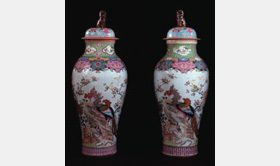Pair of Soldier Vases and Covers
Qianlong, c. 1740
European Market
Height: 53 inches (135cm)
Source: Cohen & Cohen
Download Full SpecificationBack to List...
An important pair of famille rose soldier vases and covers, each boldly enamelled around the slender body with a pair of phoenix birds perched beside rockwork on a grassy terrace issuing three peony and prunus amongst pairs of smaller birds, including cranes and doves, between a band of puce lappets around the foot and composite comma-scroll, cell-, cloud-, and wave-pattern shaped lambrequins enriched with flowerheads around the shoulder, all below a wide pale cell-pattern band reserved with deer in quatrefoil panels at the waisted neck, the covers with puce cell-pattern reserved with turquoise shaped cartouches above a trellis-pattern band at the flat rims.
The term 'soldier vase' is supposed to have come about after a trade agreement between two Fredericks: Frederick Augustus I (1670-1733), Elector of Saxony and King of Poland (known as Augustus the Strong) and Frederick Wilhelm I of Prussia. Augustus the Strong was a keen collector of Chinese and Japanese porcelain, and went on to found the Meissen porcelain factory. His collection of some 20,000 pieces was originally intended for the Porcelain Palace, which was never built, and after his death in 1733 the collection ended up in the Johanneum, where many of those pieces were engraved on the base before eventually being dispersed. Today a marked piece from this collection has considerable premium in the marketplace.
Frederick Wilhelm's great interest was the military having a particular penchant for very tall dragoons. In 1717 Augustus traded 600 soldiers of exceptional height to Frederick in exchange for 151 pieces of porcelain from the Oranienburg and Charlottenburg palaces. His group of porcelains included forty-eight blue and white covered vases of over one metre in height. Later the term became applied to any large vases and often they were paired on either side of doors just like sentries. Frederick meanwhile set up a special regiment of dragoons with his new soldiers.
This pair is richly decorated and fluidly painted. The central theme is the phoenix, the ‘queen of birds’ who represents the Empress. She is suurounded by other birds who pay her homage. These are in pairs representing mariage and fidelity. The knops of these vases are carved wooden replacements from the early nineteenth century–very likely the vases arrived in Europe with their original knops damaged and replacents were later ordered from China.
References: (for soldier vases generally)
- ANTUNES, Mary ESSL (1999) Porcelanas e Vidros, a pair of blue and white soldier vases with the arms of D. Francisco José de Sampaio Mello é Castro, the finials as gilt buddhist lions, 134 cm high.
- ANTUNES, Mary ESSL (2000) Porcelana da China, Colecção Ricardo do Espírito Santo Silva, p60, No 44, a pair in famille rose with phoenix designs, 137 cm high.
- FORBES, HA Crosby- (1982) Yang-Ts'ai: The Foreign Colours - Rose Porcelains of the Ch'ing Dynasty, p20, No 10, a pair in famille rose with phoenix, knops as Buddhist lion, 132.5cm high.
- ALVES, Jorge et al (1998) Caminhos da Porcelana - Dinastias Ming e Qing, p234, No 58, a pair in famille rose with the Portuguese arms of Sobral, 120cm high.
- WILLIAMSON, George C (1970) The Book Of Famille Rose, plate LVII, two examples, plate LVIII, two examples, in famille rose, all singles from pairs.
- HOWARD, David S (1997) A Tale of Three Cities, Canton, Shanghai and Hong Kong, p144, a pair of blue and white soldier vases with lion knops, c1730, 105cm high.
- JÖRG, CJA (1995) Oosters Porslein, p103, No 46 a pair of soldier vases with armorial decoration.
- PINTO DE MATOS, MA (2003) Chinese Porcelain in the Calouste-Gulbenkian Collection, p 202, Cat 58 a famille rose pair with very similar designs to this pair.
- BUERDELEY, Michel (1962), Porcelain of the East India Companie, p165, Cat 69, a single vase very similar to these.
Ex. Edmund de Rothschild collection
Sold GBP 200,000 to a private Middle Eastern collector


